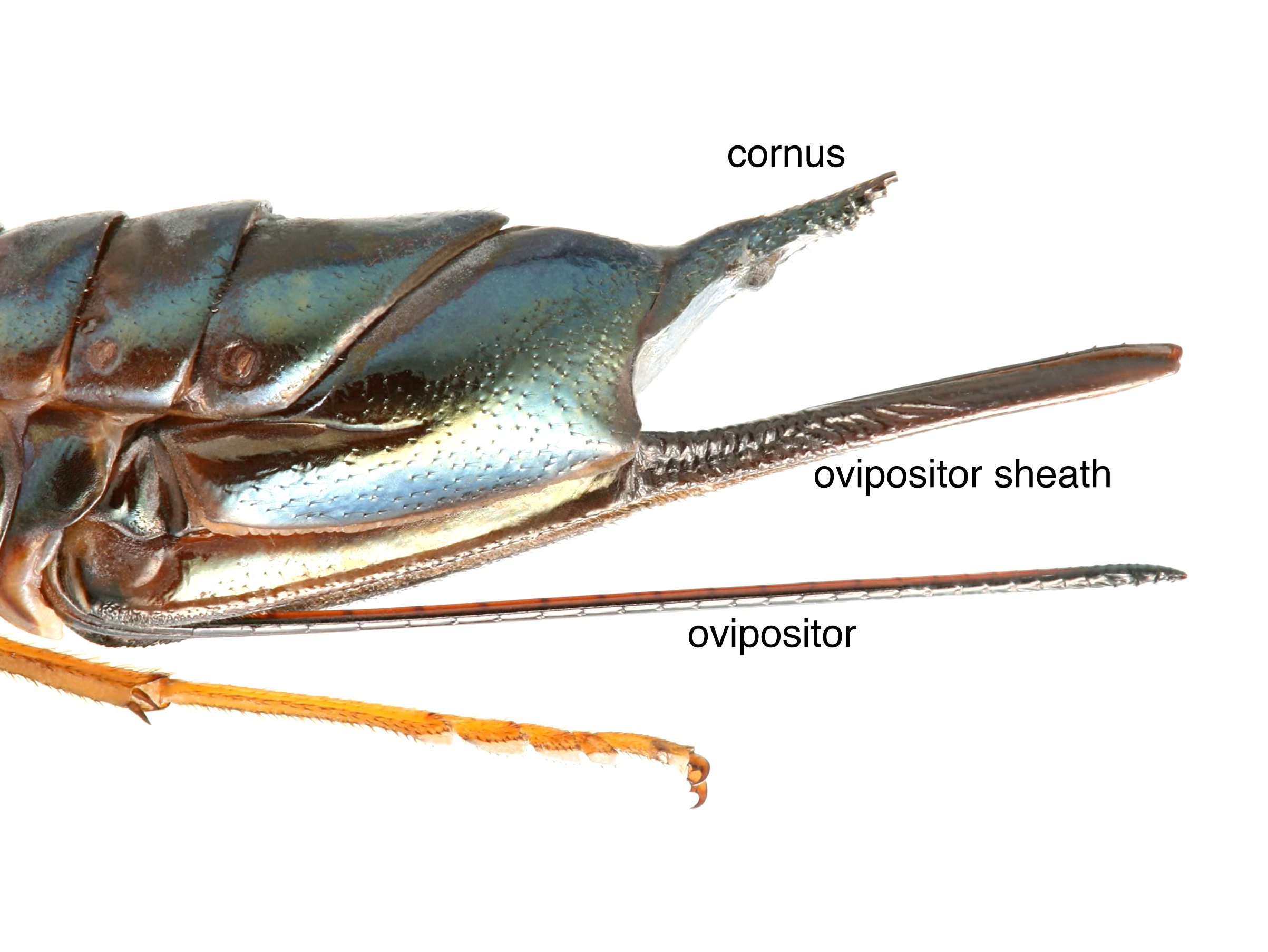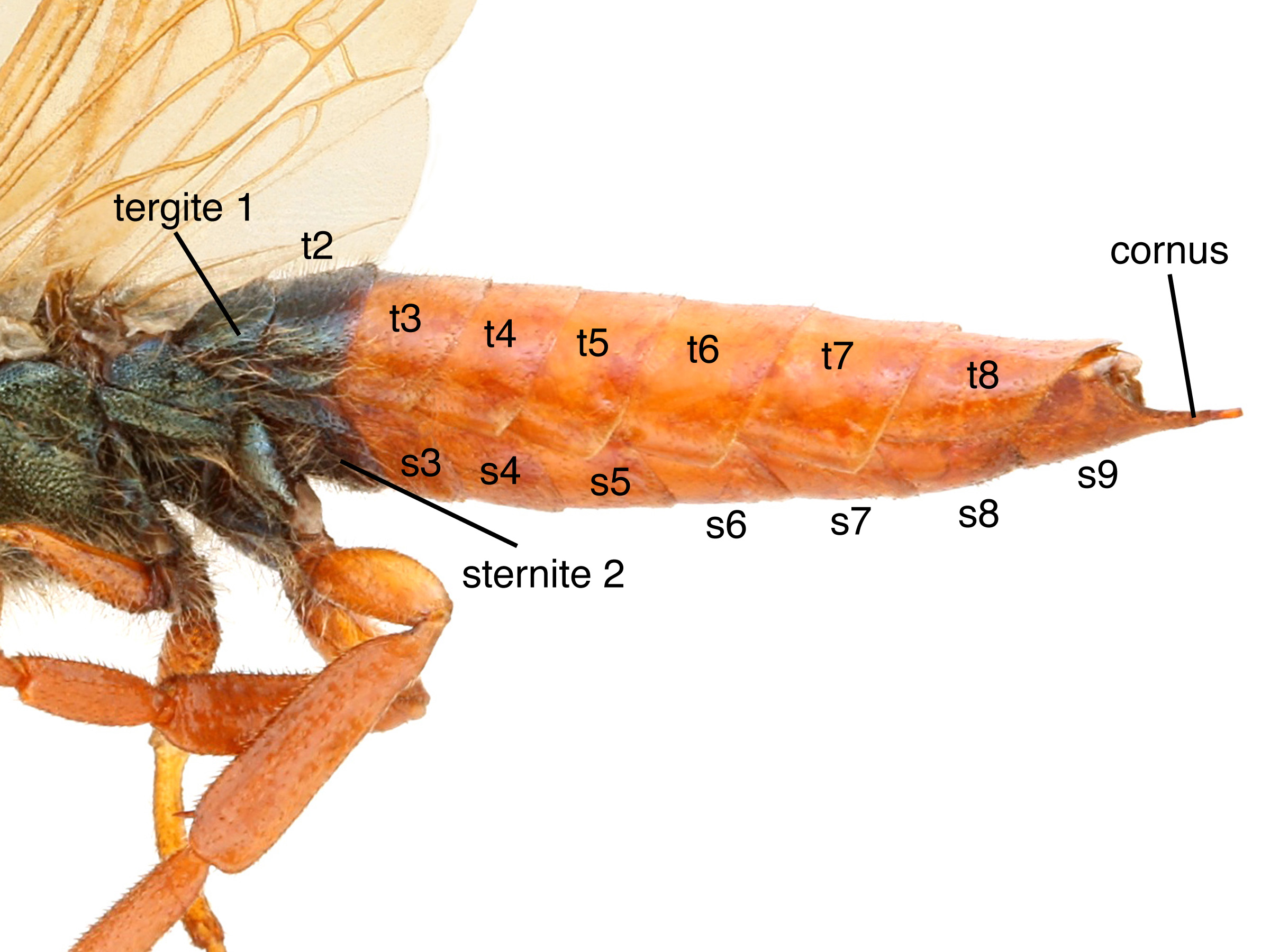Family: Siricidae
Subfamily: Siricinae
Genus: Sirex Linnaeus, 1760
Species: Sirex imperialis W.F. Kirby, 1882
Common names: none
Sirex imperialis is a completely dark form species known from India (Benson 1943Benson 1943:
Benson RB. 1943. Studies in Siricidae, especially of Europe and southern Asia (Hymenoptera, Smphyta). Bulletin of Entomological Research 34 (1): 27-51. https://doi.org/10.1017/S0007485300023464).
See Sirex for genus-level diagnostic characteristics.
Females:
 slightly darkened (Kirby 1882Kirby 1882:
slightly darkened (Kirby 1882Kirby 1882: length to fore wingfore wing:
length to fore wingfore wing: length ratio about 1:1.3 (Benson 1943Benson 1943:
length ratio about 1:1.3 (Benson 1943Benson 1943:Males:
 mostly blue-black with a thin margin of reddish-brown at the apexapex:
mostly blue-black with a thin margin of reddish-brown at the apexapex: (Rohwer 1915Rohwer 1915:
(Rohwer 1915Rohwer 1915: yellow-tinted (Rohwer 1915Rohwer 1915:
yellow-tinted (Rohwer 1915Rohwer 1915:The female S. imperialis is similar to S. noctilio, S. nitobei, and S. mongolorum in its range and can be distinguished by the completely dark legs and darkened wings (Benson 1943Benson 1943:
Benson RB. 1943. Studies in Siricidae, especially of Europe and southern Asia (Hymenoptera, Smphyta). Bulletin of Entomological Research 34 (1): 27-51. https://doi.org/10.1017/S0007485300023464).
none recorded
Sirex species feed on trees of Pinaceae and Cupressaceae. Sirex imperialis is recorded feeding on Abies pindrow (west Himalayan fir), Abies spectabilis (east Himalayan fir), Cedrus deodara (Himalayan cedar), Picea smithiana (morinda spruce), and Pinus roxburghii (chir pine) (Smith 1978Smith 1978:
Smith DR. 1978. Suborder Symphyta (Xyelidae, Parachexyelidae, Parapamphiliidae, Xyelydidae, Karatavitidae, Gigasiricidae, Sepulcidae, Pseudosiricidae, Anaxyelidae, Siricidae, Xiphydriidae, Paroryssidae, Xyelotomidae, Blasticotomidae, Pergidae). Hymenopterorum Catalogus 14: 1-193., Xiao and Wu 1983Xiao and Wu 1983:
Xiao G and Jian W. 1983. The siricid wood wasps of China (Hymenoptera, Symphyta). Scientia Silvae Sinicae Memoirs of Forest Entomology 8: 1-29.).
Female Sirex harbor symbiotic basidiomycete fungus in abdominal glands called mycangia. During oviposition, the site is inoculated with the fungus (Amylostereum spp.), which begins to decompose the surrounding wood. LarvaeLarva:
the immature stage of holometabolous insects
 feed on the fungus, and in the process bore galleries through the wood (Schiff et al. 2012Schiff et al. 2012:
feed on the fungus, and in the process bore galleries through the wood (Schiff et al. 2012Schiff et al. 2012:
Schiff NM, Goulet H, Smith DR, Boudreault C, Wilson AD, and Scheffler BE. 2012. Siricidae (Hymenoptera: Symphyta: Siricoidea) of the Western Hemisphere. Canadian Journal of Arthropod Identification 21: 1-305.). The mycangia of S. imperialis harbors Amylostereum chailletii fungus (Tabata et al. 2012Tabata et al. 2012:
Tabata M, Miyata H, and Maeto K. 2012. Chapter 7 - Siricid woodwasps and their fungal symbionts in Asia, specifically those occurring in Japan. In: Slippers B, de Groot P, and Wingfield MJ, eds. The Sirex woodwasp and its fungal symbiont: research and management of a worldwide invasive pest. Springer. https://doi.org/10.1007/978-94-007-1960-6_7).
Larvae are creamy white and grub-like in appearance with a dark head capsule. As with adults, larvaelarva:
the immature stage of holometabolous insects
 possess a short dorsaldorsal:
possess a short dorsaldorsal:
of or on the top surface of the body or structure
horn on the posterior end of the body. The larvaelarva:
the immature stage of holometabolous insects
 bore galleries into wood, feeding until pupation and subsequent emergence. Throughout this process, the larvaelarva:
bore galleries into wood, feeding until pupation and subsequent emergence. Throughout this process, the larvaelarva:
the immature stage of holometabolous insects
 use their horn to pack the tunnel behind them with sawdust. Emergence holes are perfectly circular. The fungal symbiont is carried in specialized organs in female larvaelarva:
use their horn to pack the tunnel behind them with sawdust. Emergence holes are perfectly circular. The fungal symbiont is carried in specialized organs in female larvaelarva:
the immature stage of holometabolous insects
 that develop into the mycangia after metamorphosis (Schiff et al. 2012Schiff et al. 2012:
that develop into the mycangia after metamorphosis (Schiff et al. 2012Schiff et al. 2012:
Schiff NM, Goulet H, Smith DR, Boudreault C, Wilson AD, and Scheffler BE. 2012. Siricidae (Hymenoptera: Symphyta: Siricoidea) of the Western Hemisphere. Canadian Journal of Arthropod Identification 21: 1-305.).
Though S. imperialis is documented ovipositing into trees that are already dead, they are known for causing extensive damage to wood in the northwest Himalayas, making it unusable for many puposes. The flight period in high elevations is the month of July (Stebbing 1904Stebbing 1904:
Stebbing EP. 1904. Insect life in India and how to study it, being a simple account of the more important families of insects with examples of the damage they do to crops, tea, coffee, and indigo concerns, fruit and forest trees in India. Chapter V. Order IV - Hymenoptera. Journal of Bombay Natural History 16: 115-131.).
There is one record of a parasitoid wasp, Rhyssa sp., emerging from a S. imperialis larvalarva:
the immature stage of holometabolous insects
 (Stebbing 1904Stebbing 1904:
(Stebbing 1904Stebbing 1904:
Stebbing EP. 1904. Insect life in India and how to study it, being a simple account of the more important families of insects with examples of the damage they do to crops, tea, coffee, and indigo concerns, fruit and forest trees in India. Chapter V. Order IV - Hymenoptera. Journal of Bombay Natural History 16: 115-131.).
World: Sirex imperialis is found in Pakistan, the Assam, Himachal Pradesh, Meghalaya, Jammu and Kashmir, and Punjab states of India, and the Guizhou, Zhejiang, and Anhui provinces of China (Kirby 1882Kirby 1882:
Kirby WF. 1882. List of Hymenoptera with descriptions and figures of the typical specimens in the British Museum. Vol. 1 Tenthredinidae and Siricidae. Taylor and Francis, London., Benson 1943Benson 1943:
Benson RB. 1943. Studies in Siricidae, especially of Europe and southern Asia (Hymenoptera, Smphyta). Bulletin of Entomological Research 34 (1): 27-51. https://doi.org/10.1017/S0007485300023464, Smith 1978Smith 1978:
Smith DR. 1978. Suborder Symphyta (Xyelidae, Parachexyelidae, Parapamphiliidae, Xyelydidae, Karatavitidae, Gigasiricidae, Sepulcidae, Pseudosiricidae, Anaxyelidae, Siricidae, Xiphydriidae, Paroryssidae, Xyelotomidae, Blasticotomidae, Pergidae). Hymenopterorum Catalogus 14: 1-193., Xiao and Wu 1983Xiao and Wu 1983:
Xiao G and Jian W. 1983. The siricid wood wasps of China (Hymenoptera, Symphyta). Scientia Silvae Sinicae Memoirs of Forest Entomology 8: 1-29., Saini et al. 2006Saini et al. 2006:
Saini MS, Blank SM, and Smith DR. 2006. Checklist of the sawflies (Hymenoptera: Symphyta) of India. Pp. 575-612. In: Blank SM, Schmidt S, and Taeger A. eds. Recent sawfly research: synthesis and prospects. Goecke amp; Evers, Keltern.).
North America: not recorded
No specific locality data was available for mapping the range of this species at the time of publication.